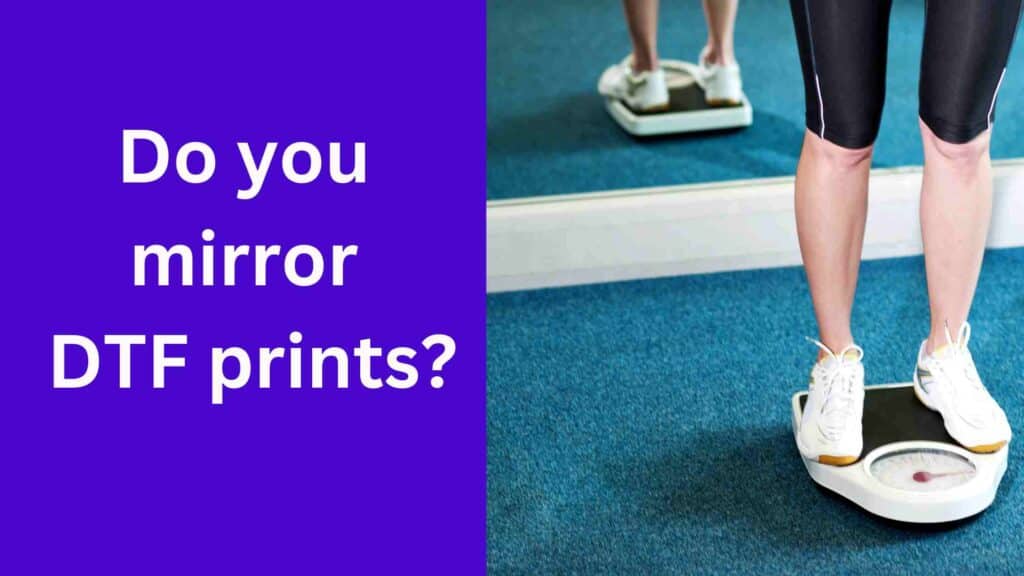Digital designs called DTF (Direct To Film) graphics are produced on a specific transfer film. Then they are applied to a garment or other object using a heat press. Due to its capability to produce top-notch, full-color prints on a variety of materials, this printing method has grown in popularity recently. However, a frequent query is whether mirroring DTF images prior to printing is necessary. Do DTF images need to be mirrored? In this article, we will examine the situations in which mirroring is required as well as those in which it is not. We will also discuss how to mirror artwork inside of CADlink software for DTF printing and provide some concluding remarks.

What are DTF images?
Digital designs are produced using a DTF printer using a unique transfer film to create DTF (Direct To Film) pictures. A unique kind of ink that is designed to stick to the transfer film is used by the printer.
In order for the design to display appropriately when transferred to a garment or another item, it is printed on the film in reverse (mirrored). The object is then covered with the transfer film using a heat press. Doing so activates the adhesive and bond the design to the surface.
We can print high-quality, full-color graphics with this technique on a wide range of fabrics, including cotton, polyester, and even hard surfaces like ceramic and metal. DTF printing is often businesses use to personalize garments, accessories, promotional goods, and unique art prints.
Why would DTF images need to be mirrored?
It’s critical that you first understand how the transfer procedure works in order to fully understand why DTF photos can need to be mirrored. The item’s surface is covered with the transfer film containing the DTF image, printed side down, during the transfer process. The adhesive is then made active by heating the back of the film, which causes the ink to transfer to the object’s surface.
How mirroring affects the final product
Do you mirror DTF transfers? Mirroring ensures that the transferred design displays accurately on the object. The design will show up correctly oriented on the object if it is mirror imaged before printing onto the transfer film.
For instance, if you print the word “LOVE” on a t-shirt without mirroring the design, the word will appear backwards on the garment. The design will, however, transfer to the shirt appropriately if it is reversed before printing.
For designs featuring text, logos, or visuals that have a specified alignment or direction, mirroring is extremely crucial. These designs will look inverted or reversed on the object when transferred if they are not mirrored before printing. This can lead to a finished project that doesn’t seem professional and might not live up to client expectations.
Situations where mirroring is necessary

Most times when the design has a specific orientation, like text, logos, and graphics, mirroring is required. For instance, if you’re printing a logo on a t-shirt that says “ABC Company,” you’d need to mirror the design for it to show appropriately when it’s transferred to the shirt. The shirt’s logo will read backwards if it is not reversed.
Do you mirror DTF prints when it has some orientation? When the design has a left or right orientation, such as a directional arrow or a hand gesture, mirroring is also required in this case. When applied to the object in these situations, the design will be reversed if it is not mirrored.
In general, to make sure that the design will look accurately on the object when transferred, it is preferable to mirror it before printing it onto the transfer film.
When is mirroring not necessary for DTF images?
In certain circumstances, such as when the design is symmetrical or has no particular orientation, mirroring is not required for DTF pictures. For instance, if you are printing a pattern of stars or circles on a t-shirt, you may not need to mirror the design since it would look the same whatever way it is orientated.
Printing pictures for iron-on decals for vehicle windows or glasses doesn’t need mirroring either.
Think about the finished result and planned design when deciding whether or not to mirror your DTF picture. Mirroring isn’t required if the design is symmetrical or does not have a particular orientation. To make sure that the text, logos, or graphics will transfer accurately to the object, it is advisable to mirror any text, logos, or images that have a set orientation or direction.
Furthermore, deciding not to mirror the design might be a purposeful artistic decision. For instance, you wouldn’t want to duplicate the design if the statement on the t-shirt is meant to be viewed in a mirror.
How to Enable Mirroring Using CADlink Software?
For DTF images, CADlink software offers a variety of methods to enable mirroring.
First, right-click the piece of art and choose “modify” before choosing “mirror.” The artwork will mirror as a result, however the mirroring effect may be undone by repeating these procedures.
The second method is to use the “mirroring” button. You can find this button in the “job” page to turn the mirroring effect on and off.
Another option is to make mirroring available for a certain print mode.
- The user must choose “manage print modes” under “devices” in order to do this.
- Double-click on the preferred print mode, choose “color layer,” and then under “layer profile”.
- Choose “mirror vertically.”
- Before closing, the modifications should be saved. Any artwork that is imported for that particular print option will be automatically mirrored.
The fourth and last method is to make all imported artwork, regardless of print mode, mirrorable. To do this:
- Go to “queue” and choose “manage queues.”
- Go to “layout manager” under “show queue properties,” then choose “mirror job on import.”
- No matter the print mode, this will immediately mirror any imported art.
It is crucial to keep in mind that pressing the button, allowing mirroring in the print mode, and queuing may result in the picture being mirrored twice, giving the impression that it was not mirrored at all. It is thus advised to choose one approach and stay with it.
Overall, CADlink Software offers consumers a number of simple-to-use alternatives for enabling mirroring, and they may choose the one that suits them the best.
Conclusion
In the end, printing on translucent or dark fabrics is just one scenario where mirroring DTF images can be useful. It may not be essential and may cause picture distortion and additional design phases.
In the end, the requirements and tastes of the designer and printer will determine whether or not to mirror a DTF picture. This article discusses considerations to consider when deciding to mirror DTF pictures.
FAQs
When using DTF to print on transfer film, we need to flip the picture before printing. It will be flipped when it is moved to the end medium. The picture will be appropriately positioned on the substrate if it is previously mirrored.
When printing on transparent materials like glass or acrylic, where we can print the image normally and apply from the back, mirroring is not required.
Yes, you can mirror DTF images using CADLink software. There are several ways to do this, including using the modify option, the job tab, print mode settings, or the queue preferences.
When an image is mirrored horizontally, it is flipped along a horizontal axis. When you mirror it vertically, it flips along a vertical axis. Depending on the final substrate’s orientation and personal choice, you have to use one over the other.

Ashley Wang is a skilled sales manager with knowledge in DTF printing. She presently works for ShenLan Digital, a reputable DTF printer maker. Ashley is the best person to offer advice on selecting the most suitable DTF printer because she has tested a lot of them. She launched DTFPrinterSchool to educate individuals and organizations about DTF printing technology, providing her expertise and observations on the most recent advancements in the sector. Ashley is an invaluable resource for businesses and individuals wishing to invest in DTF printing technology because of her expertise and experience in the industry.
